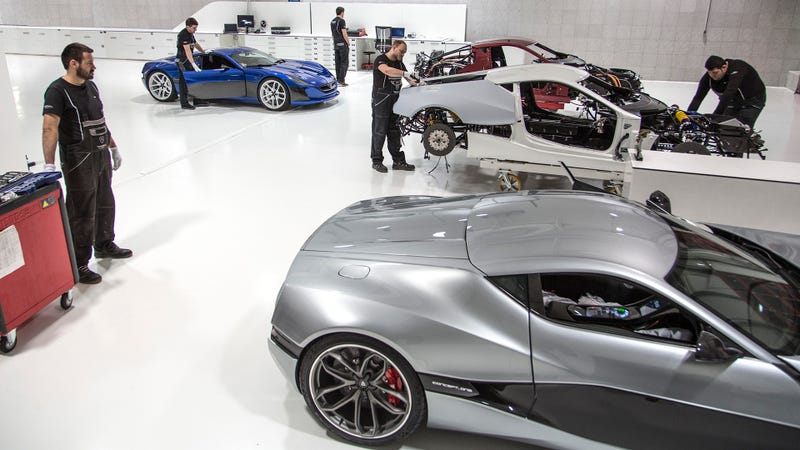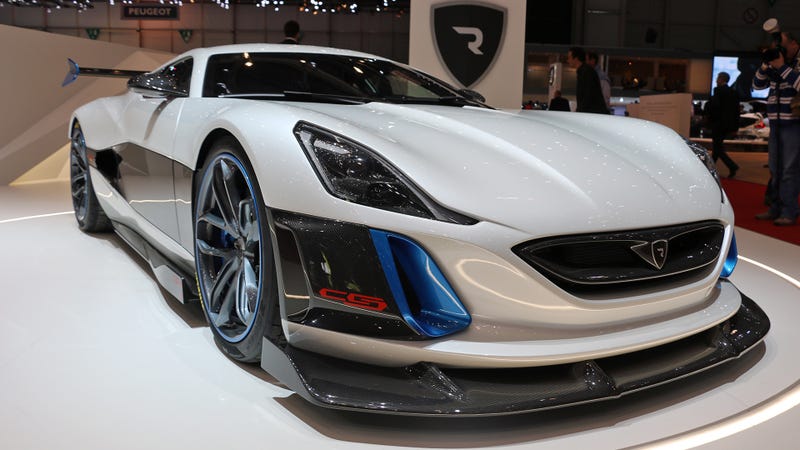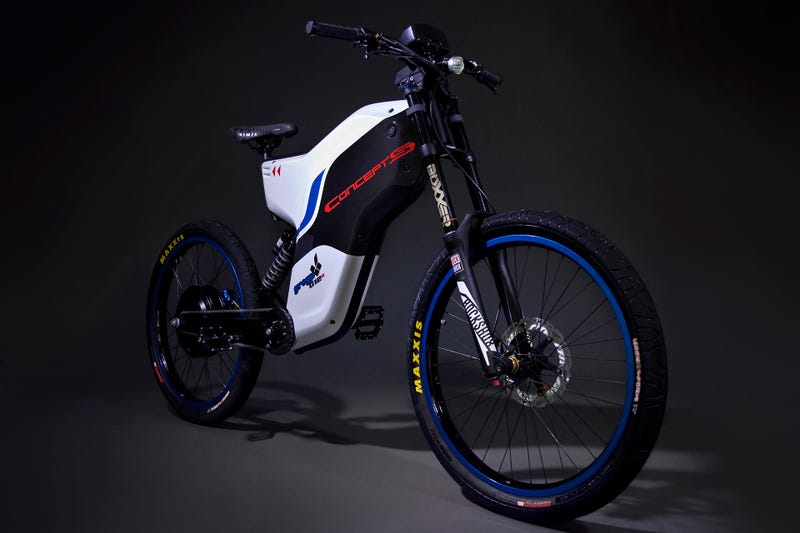HRE Wheels | The Rimac Concept_One - The Electric Hypercar - Pt.2 (Jalopnik Article)
#1
Former Vendor
Thread Starter

You may have seen already the previous article we posted in regards to the Rimac Concept_One electric hypercar, but Jalopnik just posted this article that I wanted to share with you.
How A Tiny Croatian Electric Hypercar Company Could Change Transportation Forever

When Croatian electric supercar startup Rimac presented its first prototype, it had eight employees. Today, Rimac is a team of 150, with clients like world-beating hypercar company Koenigsegg, and products like the Concept One, a 1,088 horsepower electric supercar retailing for $1 million. Yet their confidential projects are even more fascinating, even if we can’t really talk about them.
Mate Rimac started his company in 2009 after converting his BMW E30 into an electric car and realizing how fast he could get with it. He won his first race against gas-powered cars in 2010 with the prototype, and just a year later, the Concept One debuted at the Frankfurt Motor Show, with torque vectoring in both directions and huge numbers on the sheet nobody would believe.
Jalopnik first wrote about Mate Rimac’s crazy ideas in 2010, and two years later, we thought there was a slight chance his company can turn out to be the “about 1-in-600" that delivers the goods instead of a vaporware sandwich wrapped in scam foil.
-------
Launching an automotive startup in an ex-Soviet Bloc country is no walk in a park.
Rimac got no government backing, nor any support from the locals “for building cars for the rich.”
-------
Looking around at the 2016 Geneva Motor Show, the Croatians did not disappoint. With two supercars on their stand with the combined output of 2,472 horsepower and a bunch of other machines around with their technology under their panels, Rimac Automobili is now as real as it gets, even if its CEO only grew a beard to look older at business meetings.

Launching an automotive startup in an ex-Soviet Bloc country is no walk in a park. Rimac got no government backing, nor any support from the locals “for building cars for the rich.” On this side of Europe, capitalism still suffers from an image problem. Somehow, Rimac managed to endure even when the company was literally running on empty.
Setting five (still standing) Guinness and FIA world records for electric cars with a retrofitted BMW is one thing, selling million dollar supercars as a relatively unknown brand is another. Yet Rimac already sold six out of the eight Concept Ones they ever plan on making. On top of that, they also sold the only pair of their new track special, the 1384 horsepower Concept S.
That’s encouraging and a dream come true, no doubt, but it’s more important that these flagship products only represent about ten percent of what Croatia’s first car exporter actually does for a living.
When the big carmakers need to come up with new things and accelerate their electrification program due to certain lines of code in their diesels, they usually outsource the job to engineering firms such as Williams’ Tony Stark Division.
Porsche’s ridiculous options list and McLaren’s MSO customization program might bring a lot of money to the table, but know that consulting is where both companies make their highest profits. Red Bull and Aston Martin also does R&D for others, because building (race)cars is expensive, and advising others on how to do theirs can certainly pay for it.
Rimac had to go down the same route and figure out everything for themselves before trying to market their technology. Part of this was due to the lack of funding at their start. That and major suppliers such as Bosch and Continental wouldn’t even talk to a company of Rimac’s size.
After refusing to move the company to Abu Dhabi, Rimac barely got through their financial troubles four years ago, although they somehow still managed to deliver their first Concept One to a customer in 2013.
The Concept One is a clever and very complex car. It takes 16,000 metal parts and 200 made of carbon fiber to build one, and the resulting EV gives you 1,088 horsepower and 1,180 foot pounds of torque through four electric motors hidden in two housings in the middle of the axles, each equipped with their own gearboxes. The ones in the front are single speeds, but at the back, you get two-speed double-clutch units on both sides.
Don’t ask how complex the algorithm behind all that is, but what’s for sure is that Rimac’s torque vectoring system monitors each wheel more than a hundred times a second, and will calculate the optimal torque distribution between at any speed. It can also make the car understeer, feel neutral, or oversteer, depending on the selected driving mode. At the same time, it acts as a traction control, stability control and electric ABS, making the 4-wheel regenerative braking produce up to 400 kW of KERS.
Are you ready for some bonkers numbers? How about 0-62 mph in 2.6 seconds, 0-124 mph in 6.2, and 186 mph in just 14.2? These are Rimac’s claimed figures, and I would love to take them to the test just to see how my body reacts to all the instant acceleration, or some intense braking from the Concept One’s top speed of 220 mph.







During development, Rimac also realized that their motors—which have the highest power density on the market and a 97 percent efficiency rating—can do even more. In the Concept One, the rear motors’ peak output is 903 horses, but the four-wheel system’s combined total is rated at 1,088 horsepower.
For Monster Tajima’s 2015 Pike Peak racer, they went for an overall peak of one megawatt, without even calling Koenigsegg and burning any fuel. In the end, their E-Runner Concept 1 was good enough to finish second overall behind Rhys Millen’s electric prototype.
From that prototype, it was a natural progression to the Concept S, which is basically a Concept One for the track, with more aero, more power and less weight. 1,384 hp and 1,327 foot pounds of torque in this one, combined with 34 percent more downforce and a rush to 60mph in 2.5 seconds. Oh yes.
They will only build two, and both got sold before the premier at Geneva.
While it’s nice to see ultra-limited electric hypercars finally making it into production, Rimac’s biggest value is their ambition to produce as much in house as possible. The factory near the Croatian capital has everything from CNC machines to an autoclave for carbon fiber production, and a dedicated staff who can turn aluminum blocks into cutting-edge parts and come up with the right software pretty much for any application.
In order to get to this point, Rimac had to gain experience (and make money) working for others.

One of their known partners today is Koenigsegg. Christian gets the Regera’s hand-built F1-style batteries from the Croatians, and that alone says a lot about the quality of Rimac’s products.
Their know-how also came handy with Koenigsegg’s Power Distribution Unit, and the following projects we can know of:
- Chinese carmaker Qoros’ cloud-connected 40mph electric bike.
- W Motors’ Lykan Hypersport supercar, for which Rimac supplied the entire electronics, spoiler system and infotainment.
- The entire Tajima Pikes Peak car apart from the chassis. They used last year’s as a base, but only because of time limitations.
- Quadrofoil’s full electronics, powertrain and infotainment for the world’s first electric hydrofoiling watercraft.
- A wheelchair they are now commercializing.
- Greyp’s high-end ebike which starts at 8,380.00 Euros.
They plan to build 300–600 of those bikes, along with at least 100 battery packs for Koenigsegg. This is Rimac’s first step towards mass production.

Proving that they can in fact build an entire car from the ground up, the Applus Volar-E electric supercar is a Rimac through and through, and rumor has it that the company might also be working with Apple, although Mate Rimac could not comment on that when I asked him.
Creating jobs, coming up with awesome technologies, making cars faster and more efficient. Rimac very well could change transportation for the better, from a place mostly known for its nice beaches. Until now.
Photos: Rimac and Máté Petrány/Jalopnik
Full article can be found here - http://jalopnik.com/how-a-tiny-croat...cha-1765523769



